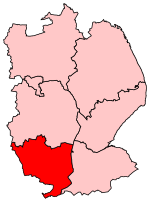St John the Evangelist's Church, Corby Glen

The Church of St John the Evangelist is a Grade I listed Church of England parish church dedicated to John the Evangelist, in Corby Glen, Lincolnshire, England. The church is 9 miles (14 km) south-east of Grantham, and in the South Kesteven Lincolnshire Vales. It is noted in particular for its 14th- and 15th-century medieval wall paintings. St John's is in the ecclesiastical parish of Corby Glen, and is part of the Corby Glen Group of Parishes in the Deanery of Beltisloe, and the Diocese of Lincoln. Other churches within the group are St Andrew's at Irnham, St Nicholas' at Swayfield, St Thomas a Becket at Bassingthorpe, St Mary Magdalene at Bitchfield and St Thomas of Canterbury at Burton Coggles.
Excerpt from the Wikipedia article St John the Evangelist's Church, Corby Glen (License: CC BY-SA 3.0, Authors, Images).St John the Evangelist's Church, Corby Glen
Church Street, South Kesteven Corby Glen
Geographical coordinates (GPS) Address Nearby Places Show on map
Geographical coordinates (GPS)
| Latitude | Longitude |
|---|---|
| N 52.8132 ° | E -0.515708 ° |
Address
Church Street
NG33 4NJ South Kesteven, Corby Glen
England, United Kingdom
Open on Google Maps











